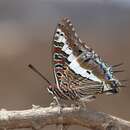en
names in breadcrumbs


Charaxes hansali, the cream-banded charaxes, is a butterfly in the family Nymphalidae. It is found in Tanzania, Rwanda, Kenya, Uganda, Sudan, Ethiopia, Somalia, Saudi Arabia, Yemen and Oman.[3]
Ch. hansali Fldr. closely approaches Charaxes pelias in the markings, but has a broad light yellow discal band extending to the inner margin of the hindwing and the basal part of the upper surface is darker black-brown; the distal yellow spots in cellules 3—7 of the forewing are small and completely separated from the band; the yellow spots at the distal margin of the hindwing are streak-like and completely separated from the distal margin by the thick black marginal line; the tails are longer than in pelias ; the light-bordered spots in the basal part of the under surface have grey centres, as in pelias. Abyssinia and the adjacent parts of Somaliland. — baringana Rothsch. only differs from the type-form in the narrower discal band of the upper surface and the free red-brown spots at the distal side of the median band on the hindwing beneath. At Lake Baringo in British East Africa. [4]
The habitat consists of arid savanna.
The larvae feed on Salvadora persica, Osyris lanceolata, Colpoon compressum;[5] and Dobera glabra.Notes on the biology of hansali are provided by [6]
Historical attempts to assemble a cluster of presumably related species into a "Charaxes jasius Group" have not been wholly convincing. More recent taxonomic revision,[11] corroborated by phylogenetic research, allow a more rational grouping congruent with cladistic relationships. Within a well-populated clade of 27 related species sharing a common ancestor approximately 16 mya during the Miocene,[12] 26 are now considered together as The jasius Group.[11] One of the two lineages forms a robust clade of seven species sharing a common ancestor approximately 2-3 mya, i.e. during the Pliocene,[12] and are considered as the jasius subgroup.[11]
The jasius Group (26 Species)
Clade 1: jasius subgroup (7 species):[11]
Clade 2: contains the well-populated three additional subgroups (19 species) of the jasius Group, called the brutus, pollux, and eudoxus subgroups.[11] Further exploration of the phylogenetic relationships amongst existing Charaxes taxa is required to improve clarity.
Charaxes hansali, the cream-banded charaxes, is a butterfly in the family Nymphalidae. It is found in Tanzania, Rwanda, Kenya, Uganda, Sudan, Ethiopia, Somalia, Saudi Arabia, Yemen and Oman.